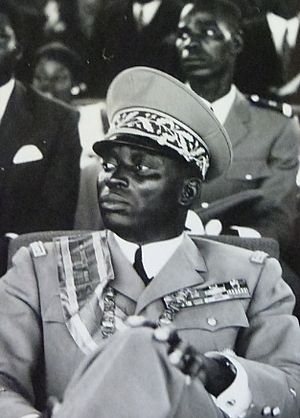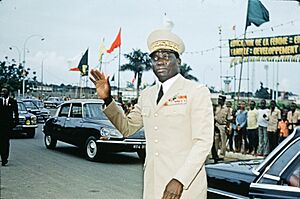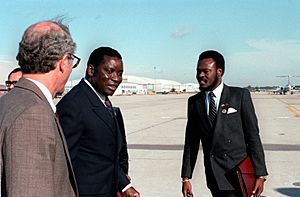Gnassingbé Eyadéma facts for kids
Quick facts for kids
Gnassingbé Eyadéma
|
|
|---|---|

Eyadéma in 1972
|
|
| 3rd President of Togo | |
| In office 14 April 1967 – 5 February 2005 |
|
| Prime Minister | Joseph Kokou Koffigoh Edem Kodjo Kwassi Klutse Eugene Koffi Adoboli Agbéyomé Kodjo Koffi Sama |
| Preceded by | Kléber Dadjo |
| Succeeded by | Faure Gnassingbé |
| Chairperson of ECOWAS | |
| In office 9 November 1975 – 1 June 1978 |
|
| Preceded by | Yakubu Gowon |
| Succeeded by | Olusegun Obasanjo |
| In office 3 June 1980 – 2 April 1981 |
|
| Preceded by | Léopold Sédar Senghor |
| Succeeded by | Siaka Stevens |
| In office 7 July 1999 – 8 September 1999 |
|
| Preceded by | Abdulsalami Abubakar |
| Succeeded by | Alpha Oumar Konaré |
| Personal details | |
| Born | 26 December 1935 Pya, French Togoland |
| Died | 5 February 2005 (aged 69) near Tunis, Tunisia |
| Political party | Rally of the Togolese People |
| Spouse | Véronica Massan |
| Children | Faure Gnassingbé |
| Military service | |
| Allegiance | Togo |
| Branch/service | Togolese Armed Forces |
| Years of service | 1958-1987 |
| Rank | |
Gnassingbé Eyadéma (born Étienne Gnassingbé, 26 December 1935 – 5 February 2005) was a military officer and politician from the country of Togo in West Africa. He served as the president of Togo from 1967 until his death in 2005. After he passed away, his son, Faure Gnassingbé, immediately took over as president.
Eyadéma was involved in two successful military takeovers, known as coups, in January 1963 and January 1967. He became president on 14 April 1967. As president, he created a political party called the Rally of the Togolese People. He led a single-party government until the early 1990s, when changes began that led to elections with multiple political parties. Even though his rule faced serious challenges in the early 1990s, he managed to regain strong control. He won presidential elections in 1993, 1998, and 2003. However, the opposition parties did not participate in the 1993 election and said the 1998 and 2003 election results were unfair. When he died, Eyadéma had been the longest-serving leader in Africa.
Early Life and Military Career
Gnassingbé Eyadéma was born on 26 December 1935 in a village called Pya, located in the northern part of Togo. He came from a farming family belonging to the Kabye ethnic group. Some people believe his official birth date might not be completely accurate, suggesting he was born around 1930. His mother was later known as Maman N'Danida.
In 1953, after finishing primary school, Eyadéma joined the French Army. He fought in the First Indochina War and the Algerian War.
After serving almost 10 years in the French army, Eyadéma returned to Togo in 1962. He played a key role in the 1963 Togolese coup d'état against President Sylvanus Olympio. During this event, Olympio was killed. Eyadéma then helped to establish Nicolas Grunitzky as the new president of Togo.
Four years later, Eyadéma had disagreements with Grunitzky. He then led a second military takeover against him. This time, no one was killed, and Grunitzky was able to go into exile in Paris. Eyadéma became president on 14 April 1967. He also made himself the Minister of Defence. He held both of these important positions for nearly 38 years.
Politics and Leadership
After taking power, Eyadéma created the Rally of the Togolese People (RPT) as the only legal political party in the country. In 1972, he won an election where he was the only candidate. In 1979, Togo adopted a new constitution. This constitution stated that the RPT was the only party allowed. The president of the party would automatically be nominated for a seven-year term as president and confirmed by a vote where no one opposed him. Under these rules, Eyadéma was re-elected without opposition in 1979 and 1986.
During his time as leader, he survived several attempts on his life. In 1974, he survived a plane crash in the northern part of the country. After another attempt on his life by a bodyguard, he kept the bullet that was removed from his body as a special charm.
In August 1991, a national meeting was held. At this meeting, Joseph Kokou Koffigoh was chosen as Prime Minister. Eyadéma was left with mostly ceremonial duties as president. Although Eyadéma tried to stop the meeting by surrounding the area with soldiers, he later accepted the results. Despite this, Eyadéma managed to stay in power with the support of the army. In March 1993, there was an unsuccessful attack on the military camp where Eyadéma lived. Several people died in this attack.
Eyadéma tried to make his rule seem more legitimate by holding a presidential election in August 1993. However, the opposition parties refused to participate. He faced only two minor opponents and won with 96.42% of the votes. But, it was reported that not many people voted outside of his home region. Eyadéma officially won re-election in the June 1998 presidential election. He defeated Gilchrist Olympio with 52.13% of the votes, according to official results. However, there were claims of cheating and accusations that hundreds of government opponents were killed. The European Union stopped giving aid to Togo in 1993 because of these alleged voting problems and human rights issues.
In late December 2002, the country's Constitution was changed. This change removed the limits on how many terms a president could serve. Before this, presidents could only serve two five-year terms. This meant Eyadéma would have had to step down after the 2003 election. With the limits removed, Eyadéma was free to run again, and he did. He won the election on 1 June with 57.78% of the votes. He was sworn in for another term on 20 June. Another change to the constitution lowered the minimum age for a president to 35 years, from 45. Since Eyadéma's son, Faure Gnassingbé, was 35, many people thought Eyadéma was preparing for his son to take over if he died suddenly.
Eyadéma built a large palace near his family home in Pya. He was the chairman of the Organisation of African Unity from 2000 to 2001. He also tried to help solve the conflict between the government and rebels in Ivory Coast during the First Ivorian Civil War, which started in 2002.
The European Union sent a group to Togo on 1 June 2004. Their goal was to check on the state of democracy in Togo and to begin a process of making Togo more democratic. The group wanted to talk with politicians from parties other than Eyadéma's. However, because of rules set by the government, some politicians refused to meet. The European Union group canceled the meeting because discussions with the government were very difficult. The European Union experts eventually met with each political figure individually and in private. They also looked into how human rights and the press were treated in Togo.
According to BBC News, Eyadéma once said that democracy in Africa "moves along at its own pace and in its own way."
Personality Cult
Eyadéma had a very strong "personality cult." This means he was presented as a hero or someone very special, and people were encouraged to admire him greatly. Here are some examples:
- He had a group of 1,000 women who would sing and dance to praise him.
- His pictures were displayed in most stores.
- There was a bronze statue of him in the capital city, Lomé.
- Wristwatches were made with his picture on them, which would disappear and reappear every fifteen seconds.
- A comic book was created that showed him as a superhero with special powers, like being unable to be harmed and having super strength.
Also, the date of a failed attempt on President Eyadéma's life was celebrated every year as "the Feast of Victory Over Forces of Evil." Eyadéma even changed his first name from Étienne to Gnassingbé to remember the date of the 1974 plane crash. He claimed he was the only person to survive this crash.
However, Eyadéma was not the only survivor of the crash on 24 January 1974. Other people also survived. He purposely changed the details of the accident to make himself seem like a hero with amazing strength who survived when everyone else supposedly died. Eyadéma claimed the crash was not an accident. He said it was a plot to kill him by powerful foreign groups who did not like his plan to take control of the important phosphate mining company in Togo.
Death
On 5 February 2005, Eyadéma died on a plane about 250 kilometers south of Tunis, Tunisia. He passed away "as he was being taken for emergency treatment abroad," according to a government statement. Officials said the cause of death was a heart attack. At the time of his death, he had been the longest-serving head of state in Africa.
Zakari Nandja, the chief of the Togolese army, announced that Eyadéma's son, Faure Gnassingbé, would be the new president of Togo. However, Alpha Oumar Konaré, the president of the African Union, immediately said this was a military takeover and against the country's constitution. Other groups, like the International Community and ECOWAS, also did not approve of Faure Gnassingbé becoming president in this way.
Due to strong pressure from ECOWAS and the international community, Faure Gnassingbé stepped down on 25 February. He was replaced by Bonfoh Abass, who was the first deputy speaker of parliament. Bonfoh Abass served as interim president until the presidential elections on 24 April 2005. In that election, Faure Gnassingbé was elected president with 60% of the votes.
Eyadéma's funeral was held on 13 March 2005. Many presidents and other important international guests attended. These included Presidents Mathieu Kérékou of Benin, John Kufuor of Ghana, Laurent Gbagbo of Ivory Coast, Mamadou Tandja of Niger, and Olusegun Obasanjo of Nigeria. On 15 March, Eyadema's family and the RPT party held a final tribute to him in his hometown of Pya.
See also
 In Spanish: Gnassingbé Eyadéma para niños
In Spanish: Gnassingbé Eyadéma para niños
- Edem Kodjo (opposition politician and coalition leader)
- Agbéyomé Messan Kodjo
- History of Togo
- Politics of Togo





